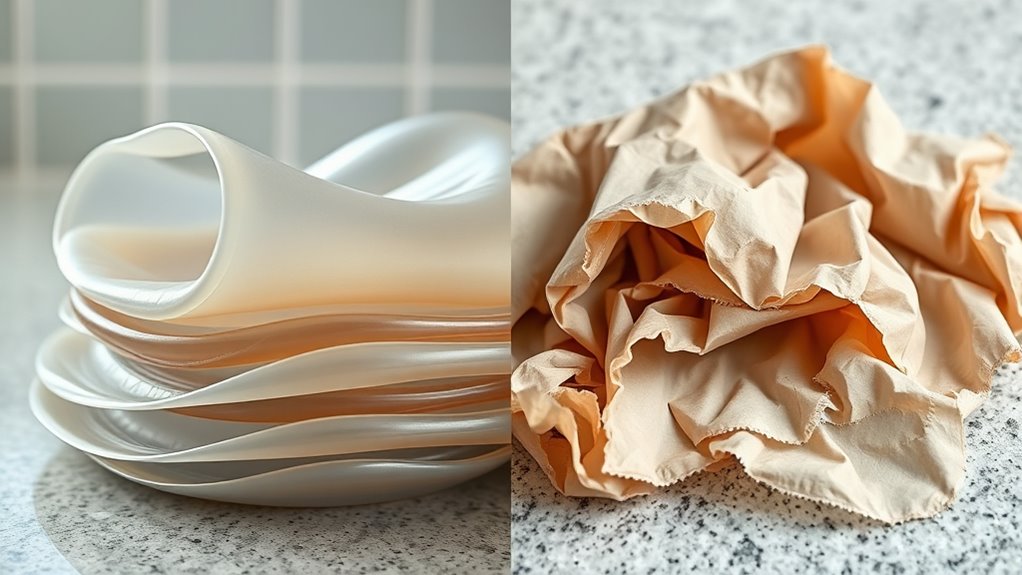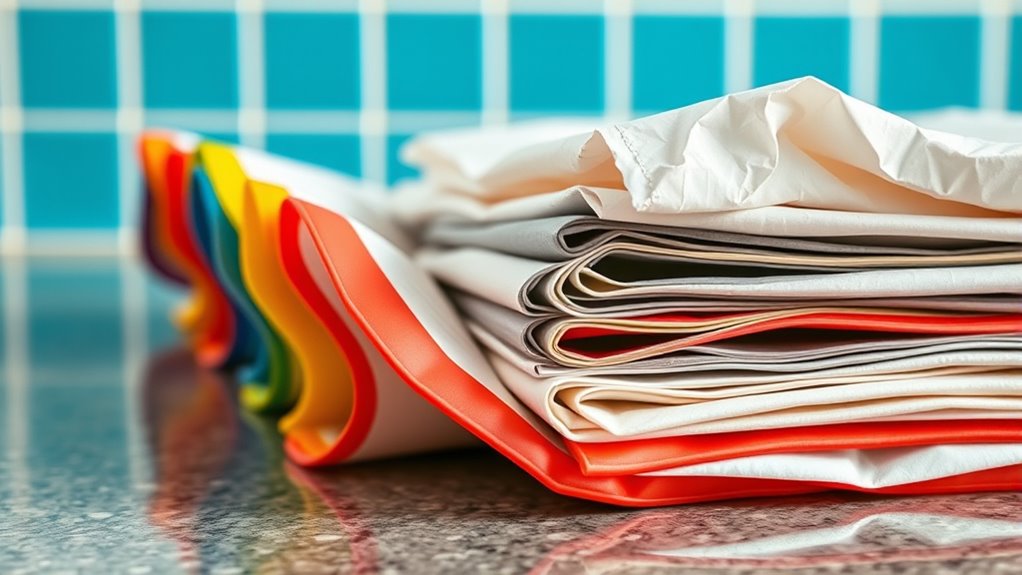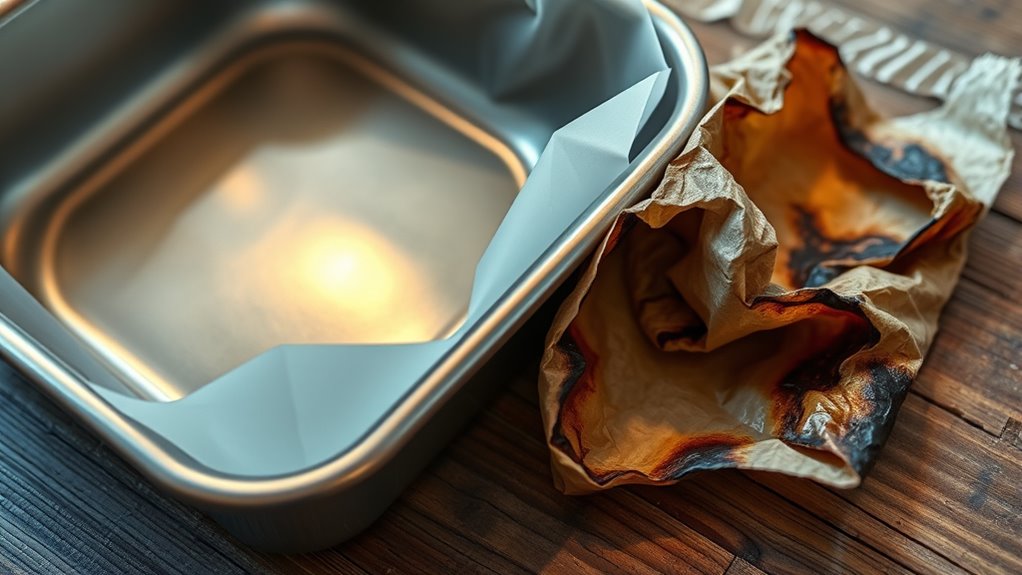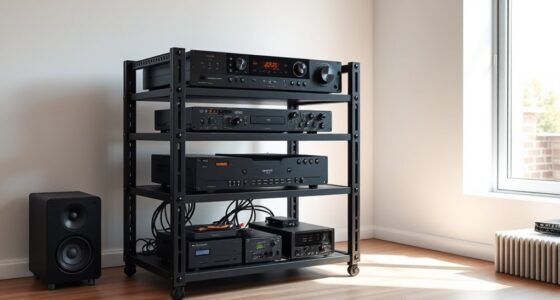Silicone liners save you more money in the long run because they’re reusable, durable, and cost $9.99–$14.99 each, while paper liners are cheap upfront but need frequent repurchasing at $0.50–$1.00 per sheet. Reusable silicone can last over a year with proper care, reducing waste and ongoing expenses. If you want to discover all the cost-saving details and environmental benefits, keep exploring the full comparison.
Key Takeaways
- Silicone liners have a higher initial cost but are reusable, leading to greater long-term savings compared to single-use paper liners.
- Reusable silicone liners last over a year with proper care, reducing the need for frequent replacements and ongoing expenses.
- Paper liners are inexpensive per sheet but require frequent repurchasing, increasing total costs over time.
- Silicone liners minimize waste and environmental impact, aligning with sustainable practices and reducing disposal costs.
- For high-frequency baking, silicone liners are more economical over time due to durability and reusability.
Cost Analysis of Reusable Silicone vs. Disposable Paper Liners

When comparing the costs of reusable silicone liners and disposable paper liners, it’s clear that initial expenses differ markedly. Reusable silicone liners typically cost between $9.99 and $14.99 each, but they can be used multiple times, making them more cost-effective over time. In contrast, disposable paper liners are inexpensive, usually $0.50 to $1.00 per sheet, but they require frequent repurchasing for ongoing use. Although the upfront cost of silicone liners is higher, their durability means they last over a year with proper care, reducing your overall expenses. Meanwhile, continuously buying paper liners adds up quickly. Over the long term, choosing reusable silicone liners not only saves money but also minimizes waste, making them the smarter, more cost-effective choice. Additionally, environmental sustainability is enhanced by reducing waste through reusable options.
Durability and Longevity of Each Liner Type

Silicone liners are built to last, often exceeding a year with proper care, making them a smart long-term choice. In contrast, paper liners are single-use and need replacement after each bake, which limits their lifespan. This difference considerably impacts both durability and ongoing costs, influencing your overall baking experience. Additionally, silicone liners provide consistent heat distribution, reducing the risk of uneven baking and further enhancing their value over time. Their reusability not only saves money but also reduces waste, making them an eco-friendly option. Moreover, silicone liners are more resistant to wear and tear, ensuring they maintain their quality through repeated use. Their ability to withstand high temperatures without melting or warping further extends their service life. The cost-effectiveness of silicone liners becomes especially clear when considering their multiple uses over the years.
Durability of Silicone Liners
Silicone liners are known for their exceptional durability, often lasting over a year with proper care, making them a cost-effective choice in the long run. Their ability to withstand repeated exposure to high temperatures without cracking or deteriorating means you can reuse them many times. Well-made, high-quality silicone liners maintain their shape and non-stick properties even after extensive use and cleaning. To maximize their lifespan, you should:
- Regularly clean with gentle soap and water
- Avoid abrasive scrubbing
- Store in a cool, dry place
- Use high-grade, dishwasher-safe options
- Handle with care to prevent tears or deformation
- Resilience of silicone ensures they remain effective over time
This durability makes silicone liners a reliable, long-lasting option, saving you money compared to single-use paper liners. Their reusability and resilience ensure you get more value over time.
Lifespan of Paper Liners
Paper liners are designed for single-use convenience, so their lifespan is limited to one cooking session. Once used, they’re discarded, making durability and reuse impossible. Their lifespan depends on usage frequency and thickness, but most are intended for one-time use only. If you’re cooking frequently, you’ll need to replace paper liners often, increasing costs. Silicone liners, on the other hand, are highly durable and can be reused hundreds of times. They may show minor signs of wear, like discoloration or small tears, but generally maintain their functionality for extensive use. Choosing silicone liners means you substantially extend their lifespan and reduce waste.
| Liners | Typical Lifespan | Reuse Potential |
|---|---|---|
| Paper Liners | One-use, limited to single cooking session | Not reusable |
| Silicone Liners | Over a year with proper care | Reusable hundreds of times |
Initial Investment vs. Long-Term Expenses

Although the initial cost of silicone liners is higher, their ability to be reused hundreds of times makes them more economical in the long run. While you spend about $9.99 to $14.99 upfront, this investment pays off through reduced long-term expenses. Reusable silicone liners eliminate the continuous need to buy disposable paper liners, saving you money over time. Keep in mind:
Reusable silicone liners, though pricier initially, save money over time with durability and repeated use.
- The initial investment is higher but offsets frequent purchases.
- Silicone liners can last over a year with proper care.
- Reusing silicone liners reduces recurring costs.
- Frequent use amplifies the cost savings.
- The total long-term expense favors silicone over paper liners.
- Proper maintenance can extend the lifespan and efficiency of silicone liners, maximizing cost savings.
Choosing silicone liners means paying more upfront but benefiting from lower ongoing expenses, making them a smarter financial choice if you cook regularly.
Environmental Impact and Cost Savings
Switching to silicone liners can substantially cut down on waste since they can be reused over a year, unlike paper liners that are discarded after each use. Although silicone liners cost more upfront, they save you money in the long run by eliminating ongoing purchases. Plus, using them helps reduce landfill waste and lessens environmental impact, making them a smarter choice for both your wallet and the planet. Additionally, choosing reusable options like silicone liners aligns with sustainable practices and supports environmental health, which is increasingly emphasized in eco-conscious sound design initiatives.
Incorporating environmental awareness into your daily routines can further enhance your positive impact on the planet.
Reusability and Waste Reduction
Silicone liners offer a sustainable alternative by being reusable and capable of lasting hundreds of uses, which greatly cuts down on waste compared to single-use paper liners. Their reusability directly impacts waste reduction and lessens the environmental impact of your baking routine. By choosing silicone, you avoid the constant disposal of paper liners, decreasing landfill contributions. Additionally, silicone liners:
- Generate less waste over time
- Require fewer resources to produce
- Lower ongoing disposal costs
- Reduce the environmental footprint of baking
- Help you cut down on single-use packaging
Furthermore, silicone liners are often made from non-toxic materials that are safe for both your family and the environment. This eco-friendly choice not only minimizes waste but also aligns with sustainable practices, making silicone liners a smarter, greener option. The durability of silicone liners means you spend less on replacements and reduce the material waste associated with disposable alternatives. Their long-term usability means significant savings over time as you need fewer replacements. Additionally, choosing reusable options like silicone liners supports environmental conservation efforts by reducing reliance on disposable products. Over the long run, they help you save money while reducing your household’s environmental impact.
Long-term Cost Efficiency
Investing in silicone liners offers significant long-term savings since they can be reused over 100 times, making them more cost-effective than constantly purchasing disposable parchment paper. With a one-time cost of around $10, reusable silicone liners help you cut down on recurring expenses and reduce waste. Over a year, they eliminate hundreds of disposable sheets, decreasing the environmental impact by minimizing landfill waste and lowering your carbon footprint. Silicone liners are durable and resistant to wear, maintaining their non-stick properties through many uses, unlike parchment paper that deteriorates quickly. This durability not only saves you money but also supports eco-friendly practices. Choosing silicone liners aligns with long-term cost efficiency and environmental responsibility, making them a smart investment for frequent air fryer users. Additionally, asset division laws can influence how costs and assets are managed when transitioning to eco-friendly kitchen tools in divorce settlements. Furthermore, selecting reusable products can promote more sustainable kitchen habits, which may include reducing waste and minimizing packaging, ultimately benefiting both your wallet and the environment. Incorporating eco-friendly materials into your kitchen routine can also enhance your overall sustainability efforts.
Maintenance and Cleaning Costs

Because silicone liners can be cleaned and reused multiple times, they tend to cost less to maintain over the long run compared to disposable paper liners. Reusable silicone liners reduce ongoing cleaning costs since they can be washed easily, often in the dishwasher, saving you time and effort. Unlike disposable paper liners, which need frequent repurchasing, silicone liners last over a year with proper care, lowering overall expenses. Their durability means you won’t have to constantly buy replacements, reducing waste and waste disposal costs. Additionally, silicone liners are often more resistant to wear and tear, further extending their lifespan and cost savings.
Practicality and Usage Frequency Benefits

While silicone liners offer long-term savings through their durability and reusability, their practicality becomes even more apparent when considering how often you cook. Because of their reusability, silicone liners are highly cost-effective for frequent usage, reducing the need for constant repurchasing. If you cook regularly, they can be used hundreds of times, making them a smart choice for high-usage households. In contrast, paper liners are convenient for occasional or one-time tasks but quickly become less economical as usage increases due to ongoing purchase costs. The ability to reuse silicone liners enhances their practicality for those who cook often, saving you money over time. Additionally, environmental sustainability is an important factor, as reusable silicone liners generate less waste compared to disposable paper liners. For infrequent cooks, paper liners may still work, but for daily use, silicone liners maximize cost-effectiveness and convenience. Reusability benefits also extend to reducing environmental impact, making silicone liners a responsible choice for eco-conscious consumers. Digital literacy programs can also help users better understand the benefits of reusable options like silicone liners.
Potential Replacement Costs and Lifespan

Reusable silicone liners typically cost between $9.99 and $14.99, but their durability means they can last over a year with proper care. Their long lifespan makes them a cost-effective choice, reducing the need for frequent replacements. Unlike disposable paper liners, which are discarded after each use, reusable silicone liners can withstand hundreds of uses. This appreciably cuts down on replacement costs over time. When considering potential replacement costs, you’ll find that investing in a reusable liner pays off in the long run. Proper care extends the lifespan of your silicone liner, ensuring you won’t need to replace it anytime soon. Keep in mind:
- High-quality silicone liners last longer
- Proper cleaning extends lifespan
- Cost per use decreases over time
- Replacement costs are minimal after initial purchase
- Reusable options provide better long-term savings
Overall Value: Which Option Provides Better Savings?

Although silicone liners may have a higher upfront cost, they deliver greater savings over time thanks to their durability and reusability. Because they cost around $9.99 and can be reused for over a year, they are a cost-effective choice for long-term savings. While parchment paper is inexpensive per sheet, frequent repurchasing adds up, increasing your total expenses and waste. Silicone liners eliminate the need for continuous purchases, saving you money and reducing environmental impact. Over the lifespan of your air fryer, investing in reusable silicone liners proves to be more economical than repeatedly buying paper liners. Ultimately, silicone liners offer better overall value by combining durability, reusability, and cost-effectiveness, making them the smarter choice for long-term savings.
Frequently Asked Questions
Are Silicone Air Fryer Liners Better Than Paper?
You might wonder if silicone air fryer liners are better than paper. Silicone liners are reusable, so you save money over time since you won’t need to buy new paper liners for each use. They’re durable, eco-friendly, and reduce waste. While the initial cost is higher, their long-term savings and environmental benefits make silicone liners a smarter choice, especially if you cook frequently and want to cut costs.
Are Silicone Cupcake Liners Better Than Paper?
You might find silicone cupcake liners better than paper because they’re reusable, saving you money over time. They keep their shape, making it easier to release cupcakes without tearing or sticking. Plus, they’re dishwasher safe, so cleaning is quick and simple. Although they cost more upfront, their durability means you won’t need to keep buying new liners, making them a smarter, cost-effective choice in the long run.
Which Air Fryer Liner Is Best?
When choosing the best air fryer liner, consider durability and cost. Silicone liners are reusable, last over a year, and cut waste, making them more economical in the long run. Paper liners are cheaper initially but need frequent repurchasing, adding to your expenses over time. If you cook often, a high-quality silicone liner is your best bet for saving money and reducing environmental impact.
Are Silicone Air Fryer Liners Safe for Health?
You might wonder if silicone air fryer liners are safe for health. Rest assured, they are made from food-grade, high-heat silicone that’s FDA-approved and free from harmful chemicals like BPA, phthalates, and lead. When used properly, they withstand up to 450°F and won’t leach toxins or react with your food. So, with correct usage and cleaning, silicone liners are a safe, non-toxic option for your air frying needs.
Is Silicone Liner Healthy?
You might think silicone liners are just safe—they’re actually a health superhero! Made from food-grade silicone, they’re BPA-free and won’t leach harmful chemicals into your food. Resistant to odors, stains, and bacteria, they keep your cooking hygienic. Plus, with proper cleaning, they stay fresh and safe over time. So, yes, silicone liners aren’t just healthy—they’re a smart, eco-friendly choice for your well-being and the planet!
Conclusion
Think of silicone and paper liners as two friends on a journey. Silicone, the loyal companion, lasts longer and saves you money over time, while paper liners are like quick visits that add up. Choosing the right one depends on how often you travel this path. If you want a steady, cost-effective partner, silicone’s your best bet. But if convenience is your focus, paper liners might be your fleeting, budget-friendly fling.








